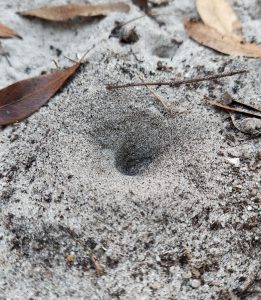
As our community continues to recover from recent storms, find helpful resources and information at tiny.cc/ufsaraext_disasterprep, tiny.cc/saraco_disasterprep, and scgov.net/government/emergency-services/storm.
This blog is part of a multi-part series. To meet other members of “The Spooky Bug Brigade,” visit our blog’s landing page.
Antlions (Myrmeleontidae)

Credit: Lyle Buss, UF/IFAS
Description

Credit: Jackie Lebouitz, UF/IFAS
You may have seen the occasional “inverted ant hill” formation out and about at your local park. This is actually the pit of an unassuming antlion, or more specifically, its young. Antlion adults are fairly unremarkable when compared to their younger, larval form. Closely related to lacewings, adult antlions have four similarly sized membranous wings, large compound eyes, and long, slender bodies that typically reach up to 3 inches in length. Their antennae are clubbed or curved and about the same length as their head and thorax (the insect’s midsection) combined. Though mostly drab shades of black or brown, some antlions have beautiful, bright accents on their wings, such as Glenurus gratus, which is commonly found in Florida.
The larvae, adorably nicknamed “doodlebugs,” are frankly anything but cute. They sport a pair of large, menacing mandibles that they use to capture unsuspecting prey. Their bodies are otherwise stout and oval in shape, usually covered in short bristles. They tend to only reach a half inch in length. Their nickname “doodlebug” describes the scribbly paths they leave behind on the surface of the sand where they walk.
There are approximately 22 species of antlion in Florida, working diligently in the background to help manage pest populations.
Services

Credit: Evgeny Kleshnev from Getty Images; designed in Canva
Antlion larvae, as you would imagine, feed primarily on ants, including the invasive red imported fire ant (Solenopsis invicta). Some species wait for their prey in pit traps, while others actively hunt for prey aboveground. You’ll often find these pits around picnic tables and other areas where ant colonies have established.
The voracious larva will patiently wait at the bottom of its pit. If an ant or other small insect happens to stumble onto it, the sand will begin to collapse under its feet, luring it deeper and deeper into its demise. As if that weren’t terrifying enough, the antlion larva will throw bits of sand at any prey that attempts escape.
Yes, it gets worse. Once at the bottom, the antlion larva will use its large, claw-like mandibles to grasp the prey and inject it with a paralytic toxin before proceeding to suck out its juices. Though horrific, the feeding habits of the larvae help reduce populations of pestiferous ants.
The adults, on a nicer note, help pollinate flowers that bloom at night, as that is when they actively forage for nectar. They also may serve as a food source for fly-eating birds and bats.
Habitat
You can find antlion larvae in sandy soil, in tree holes, or rarely under leaf litter or debris. They are well-adapted to survive in hot, dry environments. The easiest way to spot larvae is to look for their trademark pits in the sand. Adults can often be found at night near lights or visiting flowers.
Fun Fact
Talk about low maintenance – antlion larvae can survive months without food or water, and they may live up to three years in their larval form. They are also a long-standing inspiration to science fiction writers and have been featured throughout many forms of media. You can find antlion-inspired creatures in movies like Star Trek: The Wrath of Khan and Star Wars: Episode VI—Return of the Jedi, as well as the popular video game series Half-Life and Final Fantasy.
You can learn more about these small but mighty predators by clicking here.
Resources
- UF/IFAS Featured Creatures: https://entnemdept.ufl.edu/creatures/
- UF/IFAS Insect ID Lab: https://entnemdept.ufl.edu/insectid/
- IPM Florida: https://ipm.ifas.ufl.edu/
- UF/IFAS Extension Sarasota County, Chemicals in the Environment: https://sfyl.ifas.ufl.edu/sarasota/natural-resources/chemicals-in-the-environment/
Credits
- Featured image: Cristina Carrizosa, UF/IFAS
- Photos: Credited in caption
- Graphics: Designed in Canva
 2
2
